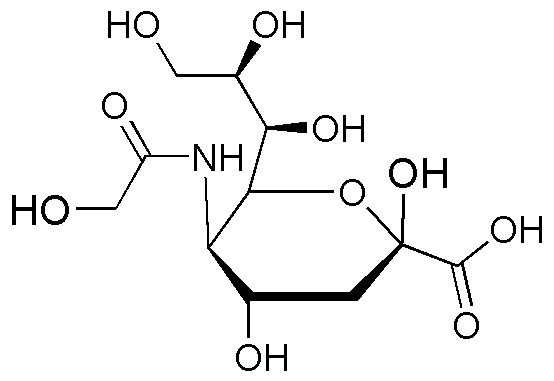N-Glycolylneuraminic acid is widely utilized in research focused on:
- Biotechnology: This compound plays a crucial role in the development of glycoproteins and glycolipids, which are essential for cell signaling and recognition processes in various biotechnological applications.
- Pharmaceuticals: It is used in the formulation of vaccines and therapeutics, particularly for targeting specific cell types, enhancing immune responses, and improving drug delivery systems.
- Food Industry: N-Glycolylneuraminic acid can be incorporated into food products as a potential functional ingredient, contributing to health benefits such as improved gut health and immune support.
- Cosmetics: Its properties make it valuable in skincare formulations, where it can help improve skin hydration and elasticity, offering anti-aging benefits.
- Research and Development: The compound is a key subject in studies related to neurobiology and cancer research, providing insights into cell interactions and disease mechanisms.
General Information
Properties
Safety and Regulations
Applications
N-Glycolylneuraminic acid is widely utilized in research focused on:
- Biotechnology: This compound plays a crucial role in the development of glycoproteins and glycolipids, which are essential for cell signaling and recognition processes in various biotechnological applications.
- Pharmaceuticals: It is used in the formulation of vaccines and therapeutics, particularly for targeting specific cell types, enhancing immune responses, and improving drug delivery systems.
- Food Industry: N-Glycolylneuraminic acid can be incorporated into food products as a potential functional ingredient, contributing to health benefits such as improved gut health and immune support.
- Cosmetics: Its properties make it valuable in skincare formulations, where it can help improve skin hydration and elasticity, offering anti-aging benefits.
- Research and Development: The compound is a key subject in studies related to neurobiology and cancer research, providing insights into cell interactions and disease mechanisms.
Documents
Safety Data Sheets (SDS)
The SDS provides comprehensive safety information on handling, storage, and disposal of the product.
Product Specification (PS)
The PS provides a comprehensive breakdown of the product’s properties, including chemical composition, physical state, purity, and storage requirements. It also details acceptable quality ranges and the product's intended applications.
Certificates of Analysis (COA)
Search for Certificates of Analysis (COA) by entering the products Lot Number. Lot and Batch Numbers can be found on a product’s label following the words ‘Lot’ or ‘Batch’.
Numéro de catalogue
Numéro de lot/série
Certificates Of Origin (COO)
This COO confirms the country where the product was manufactured, and also details the materials and components used in it and whether it is derived from natural, synthetic, or other specific sources. This certificate may be required for customs, trade, and regulatory compliance.
Numéro de catalogue
Numéro de lot/série
Safety Data Sheets (SDS)
The SDS provides comprehensive safety information on handling, storage, and disposal of the product.
DownloadProduct Specification (PS)
The PS provides a comprehensive breakdown of the product’s properties, including chemical composition, physical state, purity, and storage requirements. It also details acceptable quality ranges and the product's intended applications.
DownloadCertificates of Analysis (COA)
Search for Certificates of Analysis (COA) by entering the products Lot Number. Lot and Batch Numbers can be found on a product’s label following the words ‘Lot’ or ‘Batch’.
Numéro de catalogue
Numéro de lot/série
Certificates Of Origin (COO)
This COO confirms the country where the product was manufactured, and also details the materials and components used in it and whether it is derived from natural, synthetic, or other specific sources. This certificate may be required for customs, trade, and regulatory compliance.


